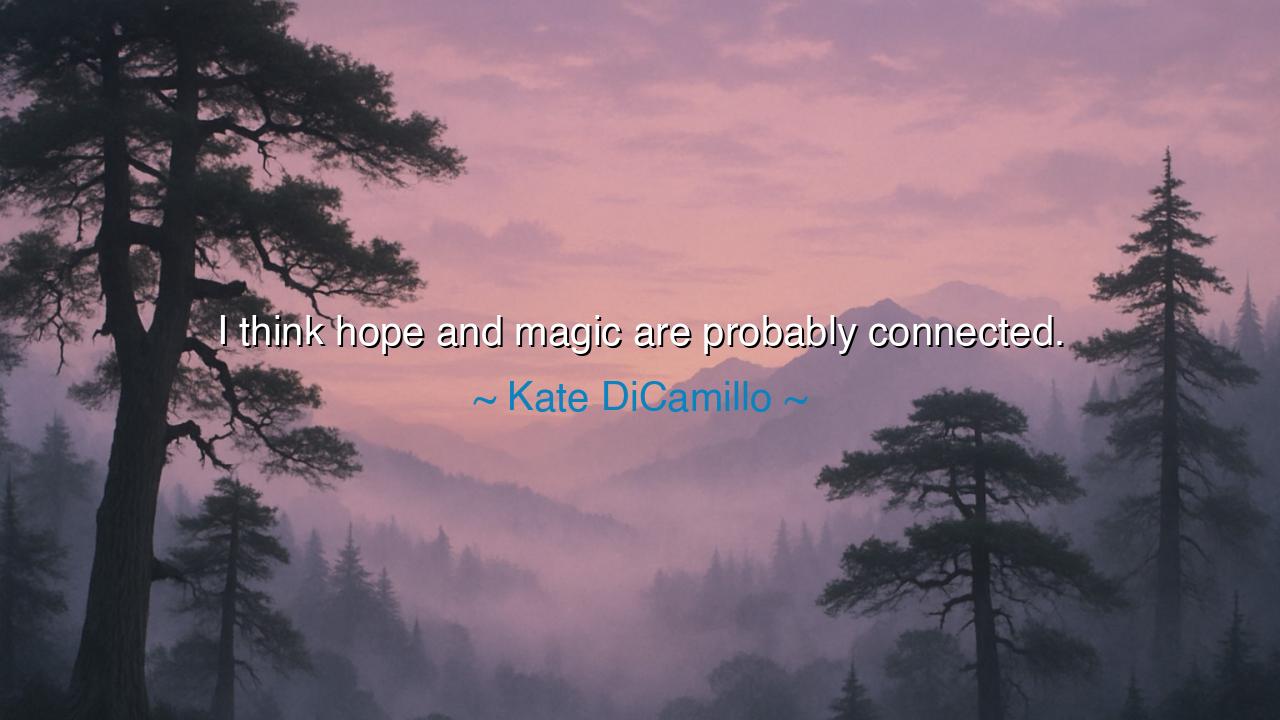
I think hope and magic are probably connected.






Kate DiCamillo once said: “I think hope and magic are probably connected.” Simple though it seems, this statement is a seed of profound truth, planted in the soil of the human heart. It carries the quiet wisdom of one who has seen both sorrow and wonder, one who knows that the greatest miracles are not always born from spells or stars, but from the stubborn light that refuses to go out within us. Hope and magic, she tells us, are bound by the same invisible thread — for both transform what is into what could be, and both require faith in what cannot yet be seen.
In the old tales, magic was the power to make the impossible real — to turn darkness into light, despair into joy, endings into beginnings. Yet, what is hope but the same power dwelling within the human soul? The magician lifts his wand; the hopeful man lifts his heart. Each acts upon a vision unseen, trusting that belief itself can shape reality. When we hope, we are performing the oldest kind of magic — not with potions or incantations, but with courage, imagination, and the quiet insistence that good will come again.
It is no accident that the great stories of humanity — from myth to scripture, from legend to literature — are woven with threads of both hope and enchantment. The ancients knew that the two are one spirit. When Pandora opened her jar and unleashed all the evils of the world, only Hope remained. Though fragile, it was divine — a spark of magic strong enough to survive even despair. When men lose armies, kingdoms, or wealth, they can still rise if they have hope; but when hope dies, no magic in heaven or earth can save them. Thus, DiCamillo’s words awaken an eternal truth: the power to endure, to believe, to love again — that is the true magic of humankind.
Consider the story of Anne Frank, the young girl who hid from the terrors of war, yet wrote in her diary, “I still believe, in spite of everything, that people are truly good at heart.” Those words were not naive; they were hope made radiant, magic born in darkness. Her body was taken by the cruelty of her time, but her hope became immortal — her faith, a spell that crossed generations. In her courage to believe, even when belief seemed foolish, Anne cast the purest magic the world has ever known: she transformed suffering into light.
Hope, then, is not merely a comfort; it is a creative force. It shapes the unseen future, bending reality toward possibility. A person who hopes acts differently — speaks more kindly, endures more bravely, dreams more boldly. Like a magician, he calls forth worlds that do not yet exist. Hope does not deny suffering; it redeems it. It says, “Yes, this is the night — but morning will come.” And that single thought, that spark of faith, is enough to turn despair into strength and loss into purpose.
Yet in the modern world, many have forgotten this truth. They seek magic only in illusions — in wealth, fame, or control — not realizing that the greatest enchantment dwells in the act of believing itself. The child who waits for his mother’s return, the artist who begins anew after failure, the mourner who chooses to love again — all are magicians of the soul. For every time we choose hope over fear, we bend the laws of fate itself.
Let this teaching be passed down like an ember from heart to heart: guard your hope as you would guard sacred fire. Do not let cynicism quench it, nor despair steal it from you. When the world grows cold, be the one who believes still — for belief is the doorway through which all miracles enter. If you cannot find magic around you, create it within you. Speak words of kindness, lift the fallen, dream when others mock you — and you will see the impossible begin to stir.
For in truth, Kate DiCamillo’s words are not a poet’s whim but a timeless revelation: hope is the oldest magic of all. It is the whisper of eternity in the mortal heart, the divine spark that defies every shadow. So live as one who knows this secret. Carry hope as your wand, love as your spell, and wonder as your guide. For in doing so, you will discover what the wise have always known — that the world itself is enchanted, and that the truest magic begins whenever the human spirit dares to hope.






AAdministratorAdministrator
Welcome, honored guests. Please leave a comment, we will respond soon